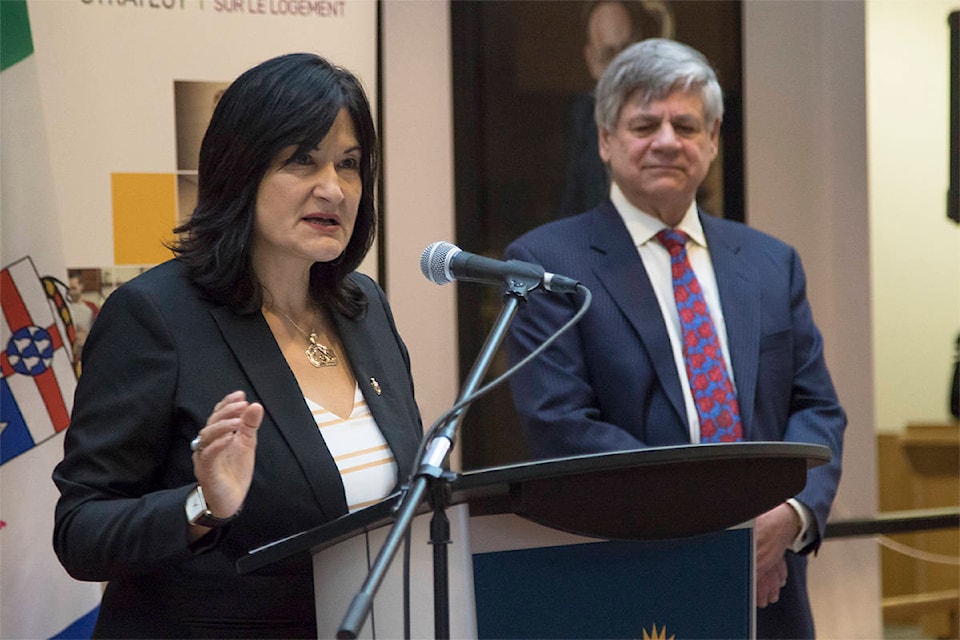Federal and Yukon governments signed a 10-year agreement which will see an additional $60 million earmarked for housing in the territory, officials said at the legislature March 14.
Of that $60 million, $42 milion is coming from the federal government, matched by $18 million from the territory. The cost-sharing agreement is part of the National Housing Strategy (NHS).
There’s also an additional $40 million in dedicated funding coming down the pipe to build new and repair existing affordable and community housing in the Yukon through the National Housing Co-investment Fund. That money is largely federal, although there are some “cost-meeting requirements” built into it, Sarah Murray, a spokesperson for the Yukon Housing Corporation, told the News.
Taken together, that’s $100 million over the next 10 years towards housing in the Yukon.
That money “is new, on top of,” the $28 million pledged in 2018 from the federal government through the Social Housing Agreement (SHA), Yukon MP Larry Bagnell said at the announcement, and is part of a national initiative to create 15 per cent more affordable housing and renew 20 percent of existing community housing units nationwide.
“It’s no secret to many people that… (Yukoners) are struggling to find housing they can afford,” he said.
The funds will go towards creating new affordable and social housing, as well as “repairing and updating existing housing,” said Pauline Frost, minister of health and social services.
Some of that money is earmarked to help repair or “preserve” 543 community housing units already operating in the Yukon, Bagnell said.
Frost called these initiatives a “right-based approach to housing.”
“First Nations have significant housing needs we have ignored for generations,” Frost added. The government needs to work with these communities to develop an “Indigenous housing strategy,” she said.
As of April 2018, vacancy rates in the Yukon hovered at around 3.4 per cent, with affordability and scarcity of both rental units and housing available for purchase a consistent topic of discussion in both the territorial legislature and the media.
The issue is felt not only in Whitehorse, where the majority of the territory’s population is concentrated, but in the communities. Bagnell said he personally knew of someone in Watson Lake who had to provide and live in a motorhome to work there.
“(The funding) also includes a plan to address the Yukon’s unique housing issues – as you know, we are unique from down south – through the Yukon Priorities Initiative,” he added.
Although it is not being officially announced today, Bagnell said the federal and Yukon governments are currently “negotiating the details” of a cost-shared housing benefit for low-income people.
As of Jan. 31, statistics from the Yukon Housing Corporation show that there are 690 social housing units in the territory. There are an additional 275 people waitlisted for social housing, including 118 seniors. The majority of those units – 479 – are in Whitehorse, where 237 people are waiting. The remainder of those units – and of the need – are spread throughout the communities, including Dawson City, which has 57 social housing units and 15 people on the waitlist.
As to what “affordable” housing really means, Pamela Hine, president of the Yukon Housing Corporation said that the definition of that “has changed” from “30 per cent of a person’s income” to a “continuum.”
The Yukon Housing Corporation did not return requests for clarification on what a “continuum” of affordability means for the average renter or buyer by press time on March 15.
Liz Hanson, Yukon NDP leader, told reporters March 7 that 30 per cent of Whitehorse residents make under $30,000 year. The News confirmed with the Yukon Bureau of Statistic that the number is actually 33.5 per cent of all Yukoners, according to the 2016 census.
If the 30 per cent income rule were still to be used to calculate affordability for housing, that would mean a single-person household making $30,000 annually would need a place to live which cost $750 a month or less.
A single Yukoner earning the new minimum wage of $12.71 an hour – which goes into effect April 1 – earns around $2,000 a month or $24,000 a year working full time. That person would need their monthly rent to be $600 a month, at the previous affordability standards, although, as a 2017 report from Yukon’s Employment Standards Board notes, “relatively few” Yukoners live on minimum wage, with more falling into the $13 to $15 an hour bracket.
According to the Yukon Bureau of Statistics, the average cost of a one-bedroom apartment in Whitehorse is $950 a month before utilities, although as the News has previously reported, that number is thought to be artificially lowered by units which have had the same renters price-locked into them for years.
With files from Jackie Hong and Julien Gignac
Contact Lori Fox at lori.fox@yukon-news.com
